Publications
[1]Houman Yaghoubi*, Alireza Dayerizadeh, Sungyub Han, Mentor Mulaj, Wenyang Gao, Xiao Li, Martin Muschol, Shengqian Ma,and Arash Takshi, "The Effect of Surfactant-Free TiO2 Surface Hydroxyl Groups on Physicochemical, Optical, and Self-Cleaning Properties of Developed Coatings on Polycarbonate", Journal of Physics D: Applied Physics 46 (5), 505316-505326, 2013.
[2] Sara Bakhshi*, Shamara Collins, Christos Ferekides, and Arash Takshi, "Study the effect of TiO2 annealing and TiCl4 treatment on the performance of Dye-Sensitized Solar Cells," 39th IEEE Photovoltaic Specialists Conference, June 16-21, Tampa, FL., 2013.
[3] Houman Yaghoubi*, Daniel Jun, J. Thomas Beatty, and Arash Takshi," Photosynthetic Reaction Center Immobilization through Carboxylic Acid Terminated\ Cytochrome C Linker for Applications in Photoprotein-based Bio-photovoltaic Devices”, MRS Proceedings, 1572, mrss13-1572-ss06-03 2013.
[4] Riaz Ahmed Liyakath, Arash Takshi*, and Gokhan Mumcu “Multilayer Stretchable Conductors on Polymer Substrates for Conformal and Reconfigurable Antennas”, IEEE Antennas and Wireless Propagation Letters, 12, 603-606 2013.
[5] Tete Tevi, Houman Yaghoubi, Jing Wang, and Arash Takshi* “Application of Poly (p-Phenylene Oxide) as Blocking Layer to Reduce Self-discharge in Supercapacitors”, Journal of Power Sources, 241, 589-596 2013.
[6] Houman Yaghoubi*, Zhi Li, Daniel Jun, Rafael Saer, Joanna E. Slota, Martin Beerbom, Rudy Schlaf, John D. Madden, J. Thomas Beatty, and Arash Takshi “The role of gold-adsorbed photosynthetic reaction centers and redox mediators in the charge transfer and photocurrent generation in a bio-photoelectrochemical cell”, Journal of Physical Chemistry C, Vol. 116, No. 47, pp. 24868-24877 2012.
[7] Arash Takshi, Houman Yaghoubi*, Daniel Jun, Rafael Saer, Ali Mahmoudzadeh, John D. Madden and J. Thomas Beatty, “Application of Wide Band Gap Semiconductors to Increase Photocurrent in a Protein Based Photovoltaic Device,” MRS Proceedings, 1414, mrsf11-1414-hh07-01 2012.
[8] Houman Yaghoubi*, Arash Takshi, Daniel Jun, Rafael Saer, John D. Madden and J. Thomas Beatty,"Free-Floating Reaction Centers (RCs) versus Attached Monolayer of RCs in Bio-photoelectrochemical Cells,” MRS Proceedings, 1414, mrsf11-1414-hh07-03 2012.
[9] Arash Takshi and John D Madden, “Study the effect of distribution of density of states on the subthreshold characteristics of an organic field-effect transistor (OFET)" Journal of Computational Electronics, 10, 1-2, 154-162 2011 .
[10] Ali Mahmoudzadeh, Rafael Saer, Daniel Jun, Mohammad Mirvakili, Arash Takshi, Bahar Iranpour, E Ouellet, Erich T Lagally, John D Madden, and John T Beatty, “Photocurrent Generation by Direct Electron Transfer Using Photosynthetic Reaction Centers,” Smart Materials and Structures, vol. 20, p. 094019 2011 .
[11] Arash Takshi, John. D. Madden, Ali Mahmoudzadeh, Rafael Saer, and J.Thomas Beatty, “A Photovoltaic Device Using an Electrolyte Containing Photosynthetic Reaction Centers,” Energies, Vol. 3, 11, 1721-1727 (2010).

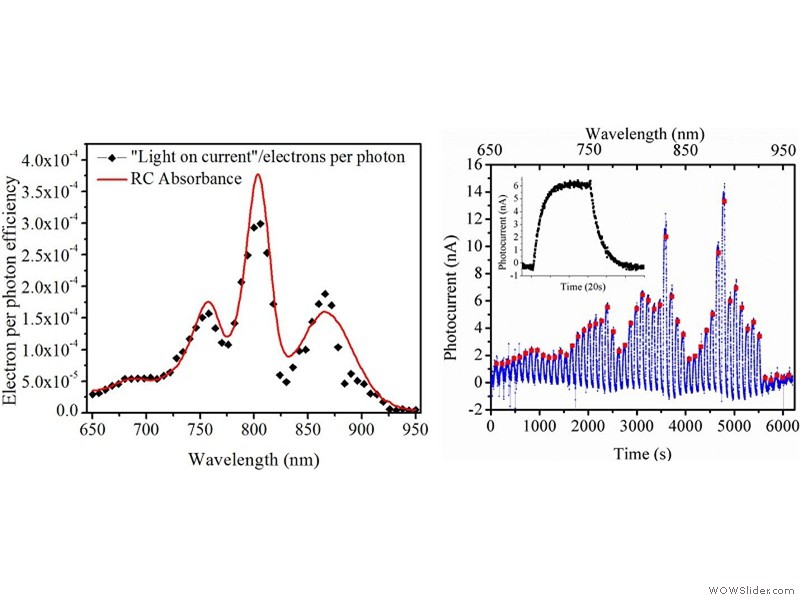 (Left) Electron per photon efficiency spectrum for the three electrode photoelectrochemical cell containing reaction center (RC) protein complexes and both charge carrier mediators, quinone and cytochrome c (black symbols), compared with the absorbance spectrum of RC in 0.1 M Tris buffer (red line). (Right) Photocurrent action spectrum obtained for the cell containing RC, Cyt c and Q2 in the electrolyte.
(Left) Electron per photon efficiency spectrum for the three electrode photoelectrochemical cell containing reaction center (RC) protein complexes and both charge carrier mediators, quinone and cytochrome c (black symbols), compared with the absorbance spectrum of RC in 0.1 M Tris buffer (red line). (Right) Photocurrent action spectrum obtained for the cell containing RC, Cyt c and Q2 in the electrolyte.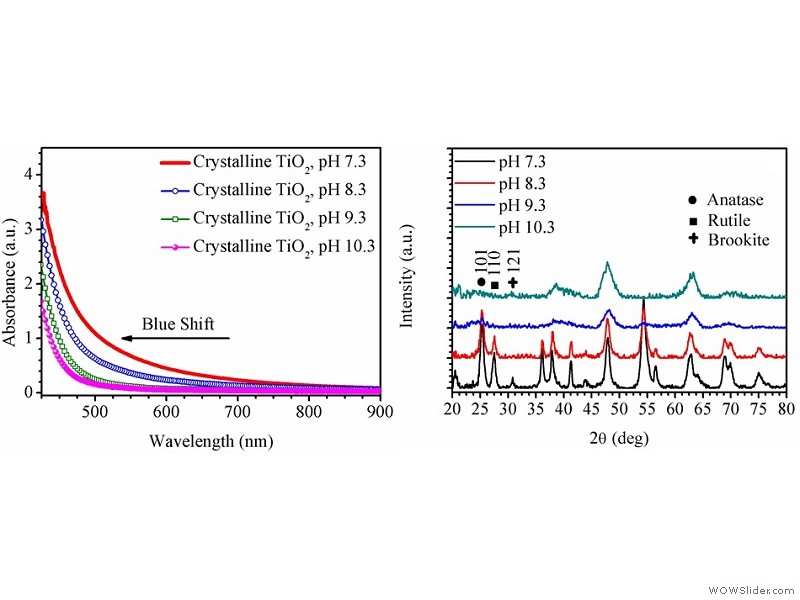 (Left) . UV–Vis optical absorption spectra of the prepared 1 wt% crystalline TiO2 suspended in water at different pH levels ranging from 7.3 to 10.3. (Right) XRD patterns of dried TiO2 crystalline particles prepared from solutions at different pH (7.3 to 10.3) annealed at 90◦C.
(Left) . UV–Vis optical absorption spectra of the prepared 1 wt% crystalline TiO2 suspended in water at different pH levels ranging from 7.3 to 10.3. (Right) XRD patterns of dried TiO2 crystalline particles prepared from solutions at different pH (7.3 to 10.3) annealed at 90◦C.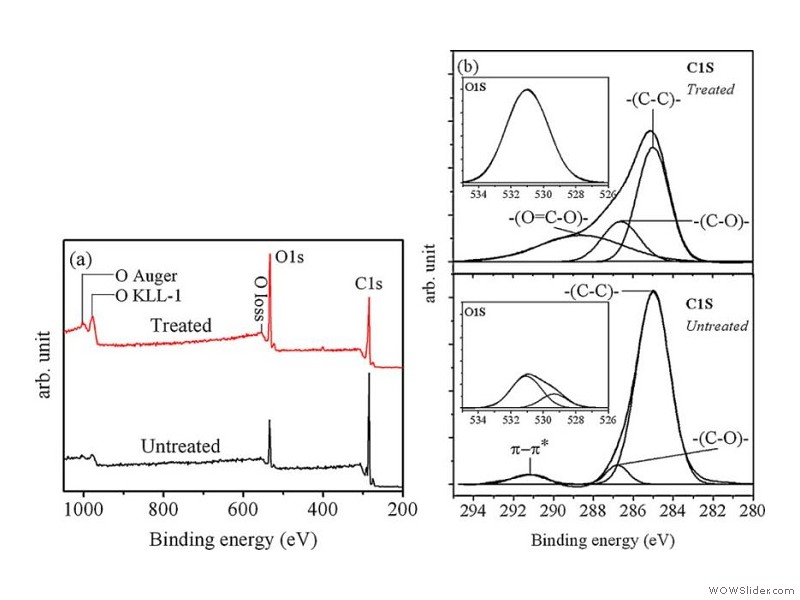 (Left) XPS survey spectra of treated and untreated surfaces and (Right) C1s and O1s core spectra of the treated and untreated surfaces.
(Left) XPS survey spectra of treated and untreated surfaces and (Right) C1s and O1s core spectra of the treated and untreated surfaces.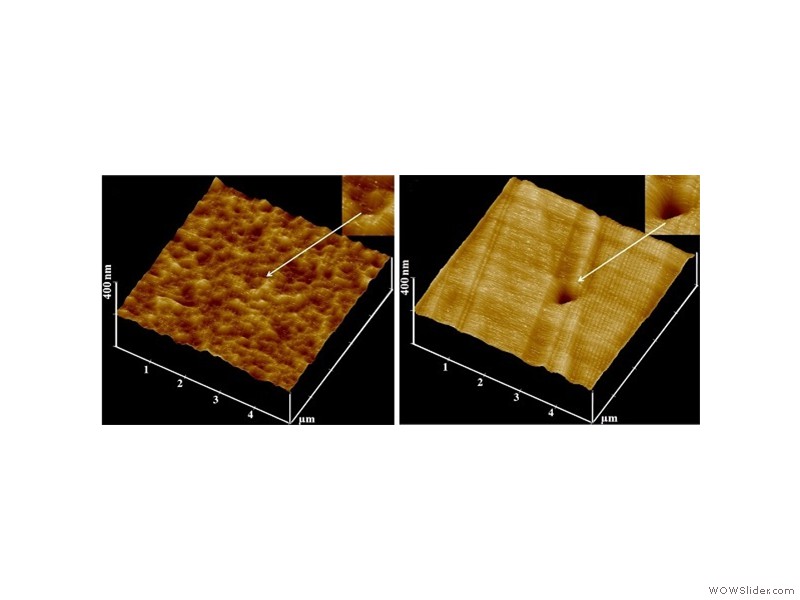 nano-indentation on PC substrate coated with TiO2 film and uncoated PC substrate.
nano-indentation on PC substrate coated with TiO2 film and uncoated PC substrate.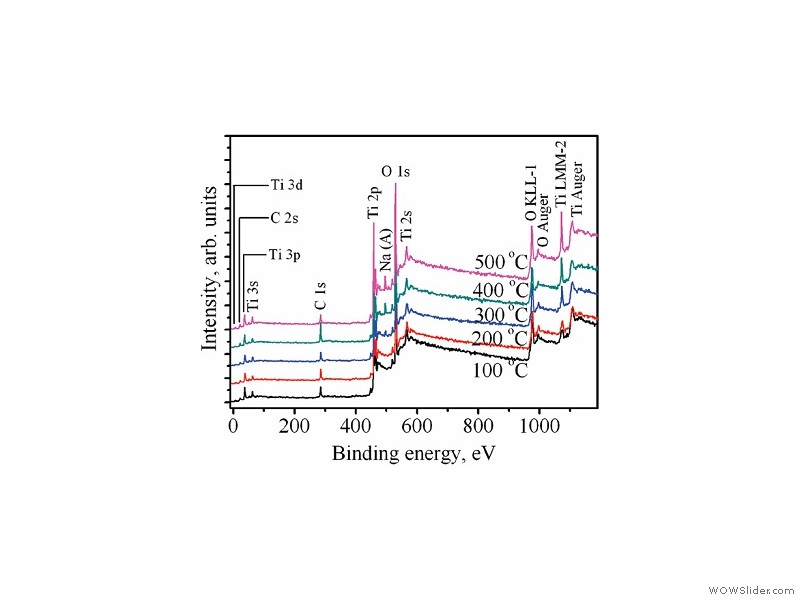 XPS survey spectra for TiO2 thin films annealed between 100 and 500 °C.
XPS survey spectra for TiO2 thin films annealed between 100 and 500 °C.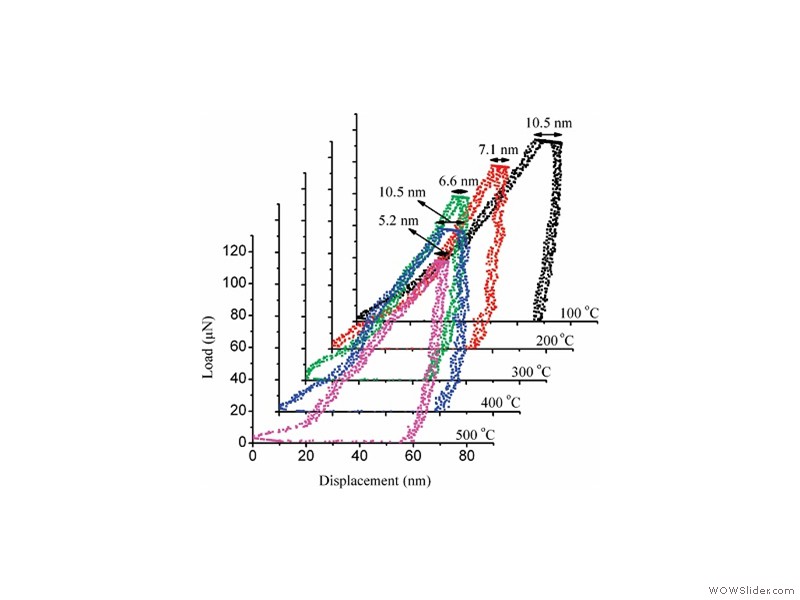 Load-displacement curves and displacement during hold time (creep) for the TiO2 films annealed between 100 and 500°C.
Load-displacement curves and displacement during hold time (creep) for the TiO2 films annealed between 100 and 500°C.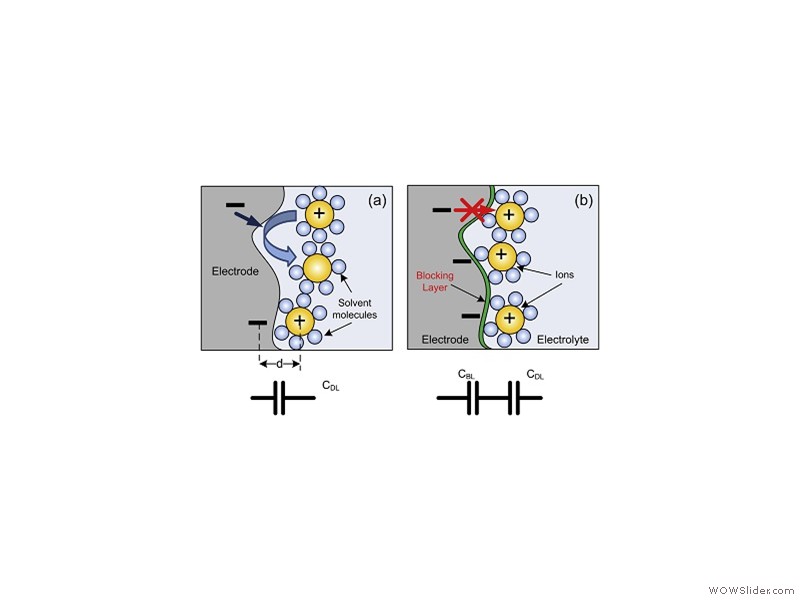 Schematics of the electrode-electrolyte interface (double layer charges) in supercapacitors. The charge arrangement can be modeled with capacitors. (a) Electrochemical reaction at the surface of the electrode results in charge loss & (b) Application of a thin blocking layer decreases the reaction rate and enhances the energy storage capability.
Schematics of the electrode-electrolyte interface (double layer charges) in supercapacitors. The charge arrangement can be modeled with capacitors. (a) Electrochemical reaction at the surface of the electrode results in charge loss & (b) Application of a thin blocking layer decreases the reaction rate and enhances the energy storage capability. 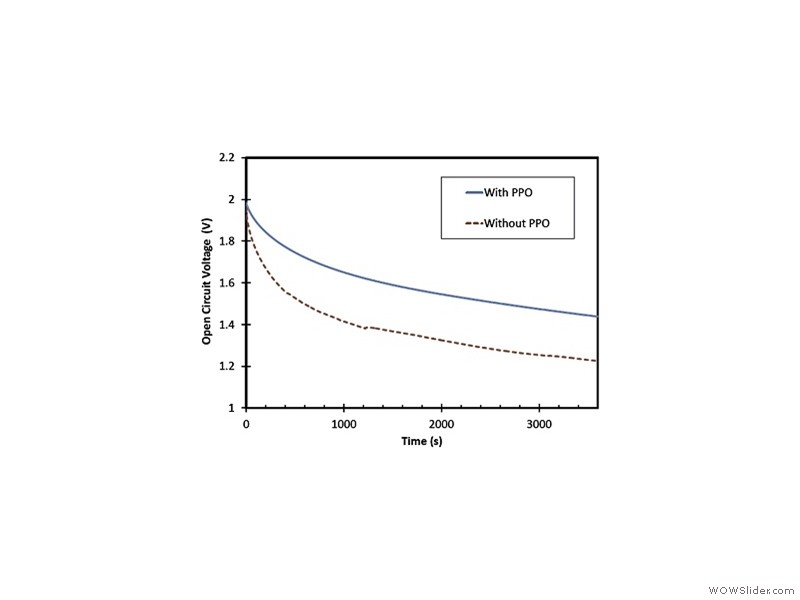 Self-discharge profile in two supercapacitors with and without the blocking layer. Both capacitors were charged at 2.0 V for 18 h prior to open circuit voltage measurement.
Self-discharge profile in two supercapacitors with and without the blocking layer. Both capacitors were charged at 2.0 V for 18 h prior to open circuit voltage measurement.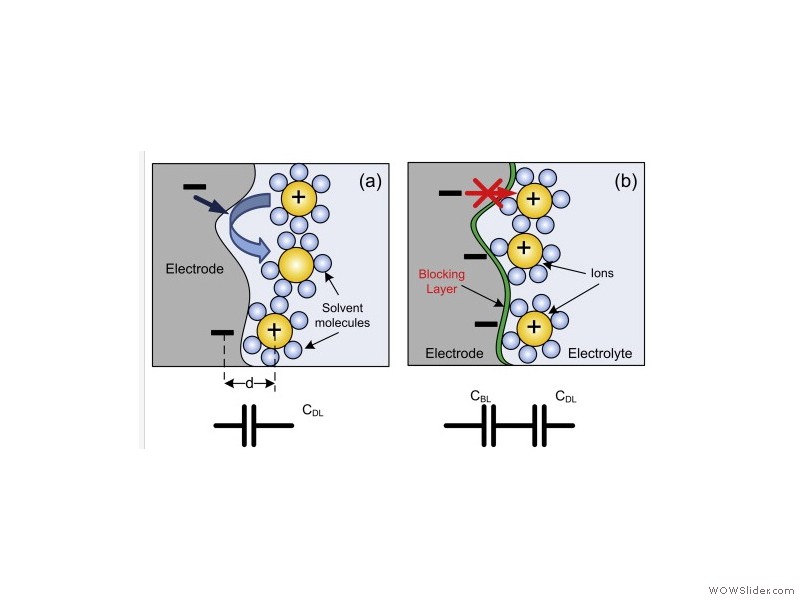 Schematics of the electrode–electrolyte interface in supercapacitors. The charge arrangement can be modeled with capacitors. (a) Leakage (charge loss ) are caused by electrochemical reaction at the surface of the electrode (b) Application of a thin blocking layer decreases the electrochemical reaction rate (From: Tevi, T., Yaghoubi, H., Wang, J., & Takshi, A. (2013). Application of poly (p-phenylene oxide) as blocking layer to reduce self-discharge in supercapacitors. Journal of Power Sources, 241, 589-596.)
Schematics of the electrode–electrolyte interface in supercapacitors. The charge arrangement can be modeled with capacitors. (a) Leakage (charge loss ) are caused by electrochemical reaction at the surface of the electrode (b) Application of a thin blocking layer decreases the electrochemical reaction rate (From: Tevi, T., Yaghoubi, H., Wang, J., & Takshi, A. (2013). Application of poly (p-phenylene oxide) as blocking layer to reduce self-discharge in supercapacitors. Journal of Power Sources, 241, 589-596.)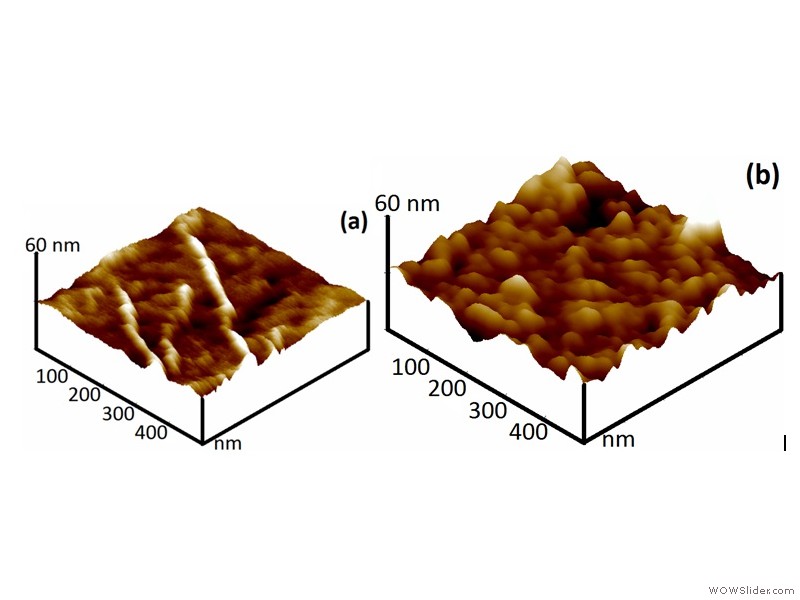 Atomic Force Microscopy 3D topographic images of: (a) a glassy carbon surface and (b) electrodeposited poly (p-phenylene oxide) on the glassy carbon electrode surface. The images were obtained in air with noncontact tapping mode. (From: Tevi, T., Yaghoubi, H., Wang, J., & Takshi, A. (2013). Application of poly (p-phenylene oxide) as blocking layer to reduce self-discharge in supercapacitors. Journal of Power Sources, 241, 589-596. Supplementary information)
Atomic Force Microscopy 3D topographic images of: (a) a glassy carbon surface and (b) electrodeposited poly (p-phenylene oxide) on the glassy carbon electrode surface. The images were obtained in air with noncontact tapping mode. (From: Tevi, T., Yaghoubi, H., Wang, J., & Takshi, A. (2013). Application of poly (p-phenylene oxide) as blocking layer to reduce self-discharge in supercapacitors. Journal of Power Sources, 241, 589-596. Supplementary information)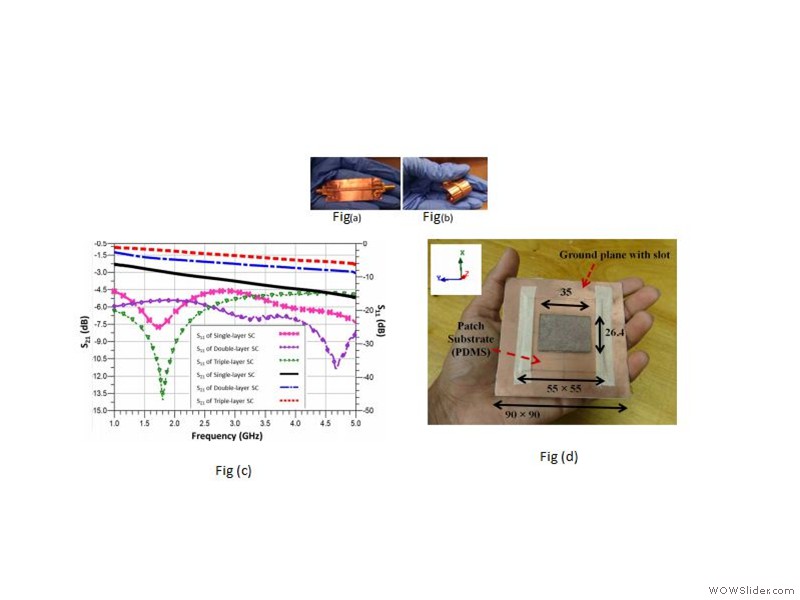 Fig a and b - Fabricated flexible triple layer sctretchable conductor, Fig c - Measured S11 and S21 performance of the flat multilayer elastic conductor in 0 % Strain condiction , Fig d - Triple layer SC based aperture coupled patch antenna.
Liyakath, R.A.; Takshi, A.; Mumcu, G., "Multilayer Stretchable Conductors on Polymer Substrates for Conformal and Reconfigurable Antennas," Antennas and Wireless Propagation Letters, IEEE , vol.12, no., pp.603,606, 2013
Fig a and b - Fabricated flexible triple layer sctretchable conductor, Fig c - Measured S11 and S21 performance of the flat multilayer elastic conductor in 0 % Strain condiction , Fig d - Triple layer SC based aperture coupled patch antenna.
Liyakath, R.A.; Takshi, A.; Mumcu, G., "Multilayer Stretchable Conductors on Polymer Substrates for Conformal and Reconfigurable Antennas," Antennas and Wireless Propagation Letters, IEEE , vol.12, no., pp.603,606, 2013 1
1 2
2 3
3 4
4 5
5 6
6 7
7 8
8 9
9 10
10 11
11